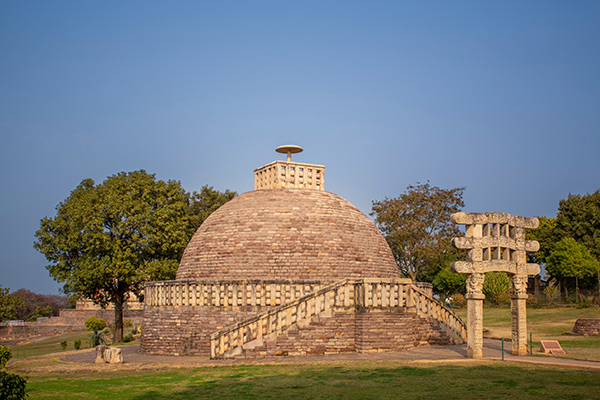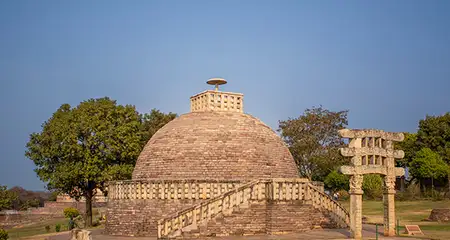Sanchi Stupa stands inside an ancient Buddhist complex in Madhya Pradesh, situated on top of a hill in a small town called Sanchi. The complex is best known for the Great Stupa, one of the oldest stone Buddhist monuments in India. With over 2,000 years of history, it remains a living example of the art and architecture that flourished during the rule of Emperor Ashoka. The Great Stupa is a UNESCO World Heritage Site and located a short trip away from Bhopal, the capital city of Madhya Pradesh. If you are a history fanatic or an admirer of architectural brilliance, step out of your hotels in Bhopal and plan a trip to the Great Stupa at Sanchi.
Want to know more about this age-old Buddhist monument? Here is everything you should know about the Great Stupa at Sanchi, including its history, timings, architecture, entry fee, and other interesting and lesser-known facts.
Sanchi Stupa Information:
| Location | Sanchi, Raisen District |
| Type | Buddhist monument |
| Status | UNESCO World Heritage Site |
| Timings | 6:30 am to 6:30 pm; every day |
| Entry Fee | ₹30 for Indians; ₹500 for foreigners |
| Distance from Bhopal | 48 km |
| Year of Construction | 3rd century BCE |
| Commissioned by | Ashoka |
| Architectural Style | Buddhist style |
| Also Known as | Great Stupa; Stupa No. 1 (in Sanchi) |
| Dimensions | 54 feet (height) and 120 feet (dome diameter) |
| Material Used | Stone |
Sanchi Stupa: History
The Great Stupa at Sanchi, also known as Stupa No.1, was commissioned by none other than the Mauryan Emperor, Ashoka, in the 3rd century BCE. It is believed that his intention behind constructing this Stupa was to preserve and spread the Buddhist philosophy and way of life. The Great Stupa is the oldest and largest Stupa at the Sanchi Buddhist Monument Complex.
The original structure built by Ashoka was not made of stone; it was a simple hemispherical monument made using bricks. Many historians presume that the Great Stupa was destroyed in the 2nd century BCE during the reign of Emperor Pushyamitra Shunga. His son, Agnimitra, reconstructed the monument and covered the original brick Stupa with stone slabs. During the latter part of the Shunga period, additional elements were added to the Stupa and as a result, it became twice its initial size. The second and third Stupas at Sanchi were also built during this period. During the Satavahana rule, i.e. in the 1st BCE, four ceremonial gateways aka toranas and an ornamented balustrade were also added to the main structure.
Over centuries, the Great Stupa came to be known as the symbol of dharma or the Wheel of Law. This Stupa along with other structures in the Sanchi Complex was functional till the 12th century. The Great Stupa and other Buddhist monuments at Sanchi were discovered in 1818 as a result of excavations. It is currently preserved by the Archeological Survey of India.
Sanchi Stupa: Architecture
The Great Stupa at Sanchi exhibits the Buddhist architectural style. With a height of 54 feet and a pedestal diameter of 120 feet, it is one of the largest of its kind in the whole country. The main structure of the Stupa is a hemispherical dome that has a simple design. The dome rests on a base, under which is a relic chamber. According to popular beliefs, the dome was constructed over the relics belonging to Lord Buddha. That is why it was adorned with three chhatris (umbrella-like structures) meant to shelter the relics. The three structures are said to stand for Triantha or the three jewels of Buddhism, namely the Buddha, the Dharma, and the Sangha. A large central pillar supports the chhatris.
The railings surrounding the Great Stupa are devoid of any artistic décor. These railings are nothing more than plain slabs bearing dedicatory inscriptions. There are four intricately ornamented ceremonial gateways that face all four directions. Scenes from Jataka stories, events of Buddha’s life, scenes from early Buddhism period, and several auspicious symbols are carved on these ceremonial gateways.
Sanchi Stupa: Today
Today, the Great Stupa at Sanchi is one of the most famous tourist spots near Bhopal and a prominent Buddhist pilgrimage site. Scores of people visit this structure every day to get a glimpse of the region’s architectural heritage and to understand the cultural history of India at a deeper level. Currently, you can see around fifty additional structures and monuments on the hilltop where the Stupa is situated.
In 1989, the Great Stupa and other Buddhist structures at Sanchi were collectively declared a World Heritage site by UNESCO for their unique cultural significance.
Things to See in the Sanchi Stupa Complex
In addition to the central structure of the Great Stupa or Stupa No. 1, the Sanchi Stupa Complex has several pillars, sculptures, and inscriptions that help you understand the history of early Buddhism in India. These include the following:
- Stupa No. 2 and Stupa No. 3, built during the reign of the Sungas
- Ashoka Pillar, an excellently polished sandstone pillar
- Temple 40, one of the first free-standing temples in India
- Sunga Pillar or Pillar 25, having a design similar to the Heliodorus pillar
- Four ceremonial gateways or toranas
- The Great Bowl
- Gupta Temple, an architectural beauty
- Monastery 51
Lesser Known Facts about Sanchi Stupa
- The Ashoka Pillar located at Sanchi Stupa Complex is known for its four lions standing back to back. The national emblem of India is derived from the Ashoka Pillar.
- The four toranas or ornate gateways were the last structures to be added to this Buddhist complex. These four gateways represent courage, love, peace, and trust.
- Though the Stupa at Sanchi was built over the relics of Lord Buddha, it is believed that he never set foot in the village of Sanchi.
- The Great Stupa of Sanchi is featured on the rear side of the new 200 rupees note.
- There are several Brahmi inscriptions on the Great Stupa and most of these are details of donations from local donors.
Attractions near Sanchi Stupa
- Sanchi Archaeological Museum (700 m)
- Chetiyagiri Buddhist Temple (1.3 km)
- Udaigiri Caves (10 km)
Away from the hustle and bustle of city life, the Sanchi Stupa takes you back in time. And after a hectic sightseeing tour through these Buddhist circuits, you can wrap up your day by enjoying a delicious meal at one of the best restaurants in Bhopal. So, why wait any longer? Go ahead and plan your trip to explore this Buddhist complex at Sanchi.




























